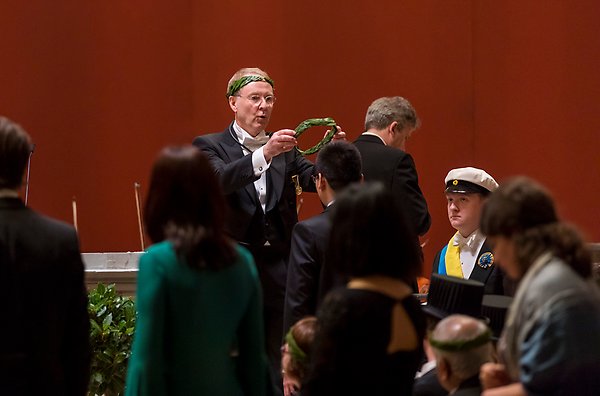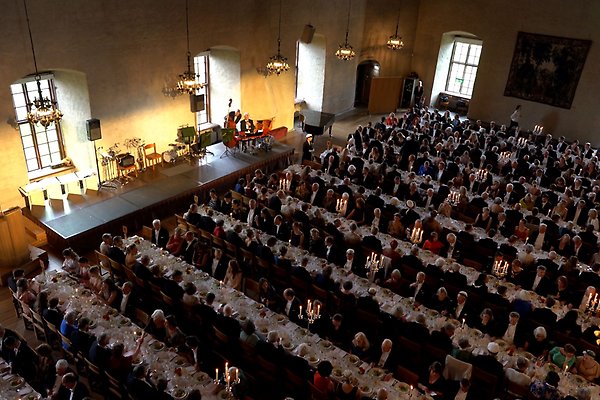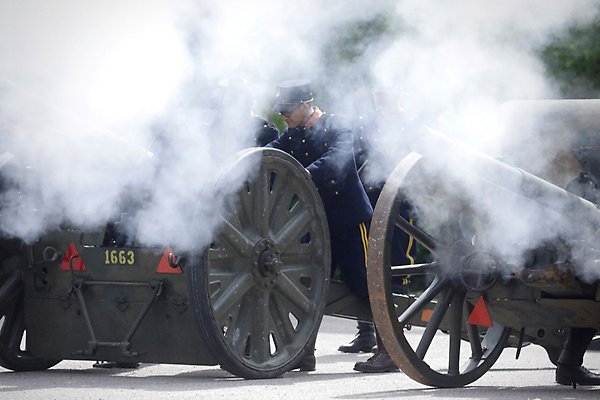Doctoral Degree Conferment Ceremony
The Doctoral Degree Conferment Ceremony is an event celebrating everyone who has completed a doctoral degree during the year. It takes place twice a year: the Winter Conferment Ceremony at the end of January and the Spring Conferment Ceremony at the end of May/beginning of June.

Doctoral Degree Conferement Ceremony, January 2018. Photo: Mikael Wallerstedt.
The Conferment Ceremony
The Conferment Ceremony is a solemn event held in the University's Grand Auditorium. Every part of the ceremony is well orchestrated and follows a well-rehearsed order.
Each faculty appoints its own degree conferrer. Reflecting the University’s long history, some of the degree conferrers conduct their part of the ceremony in Latin.
The degree conferrers give the new doctoral graduates special tokens of honour. These are called doctoral insignia and consist of a hat or laurel wreath and a diploma. Which doctors receive a hat and which receive a laurel wreath depends on which faculty they are graduating from.
There is also a third token of honour: the doctoral ring. Unlike the hat, laurel wreath and diploma, the new doctoral graduates do not receive the ring during the ceremony, but they have the right to acquire a ring themselves if they wish to.
Honorary doctors
Every year the University’s faculties select recipients of honorary doctorates. The University then invites the honorary doctors to the Winter Conferment Ceremony, where they receive all three tokens of honour: hat or laurel wreath, diploma and ring.

The festivities continue into the evening, with a banquet in the Hall of State at Uppsala Castle. Usually close to 700 people take part in the Conferment Ceremony banquet – the new doctors, jubilee doctors and honorary doctors with families, invited guests of honour, academic staff and other university employees.
Cannon salute and bell-ringing
The people of Uppsala are alerted to the Conferment Ceremony by the sound of cannons fired at 07:00 in the morning and later at intervals between 12:50 and 15:00 in the afternoon.
No records reveal precisely when the University started honouring new doctoral graduates with a cannon salute, but we do know it has been done since at least the early 19th century.
Another sound the people of Uppsala hear on the day of the Conferment Ceremony is the ringing of the great bell of Uppsala Cathedral.

In the morning, cannons are fired from the grounds of Uppsala Castle and in the afternoon from the University Main Building. Photo: Mikael Wallerstedt.
If you have defended a doctoral thesis
If you have defended a doctoral thesis at Uppsala University, meet all the requirements for a doctoral degree and wish to have the degree conferred upon you, you need to register for the Conferment Ceremony.
For newly qualified doctoral graduates, registration opens on 1 March for the Spring Conferment Ceremony and on 1 October for the Winter Conferment Ceremony. The deadline for registering is 1 April for the Spring Conferment Ceremony and 1 November for the Winter Conferment Ceremony.
More information about and how to register for the Doctoral Degree Conferment Ceremony
Conferment Ceremony Glossary
Absens
Absens means absent. Some jubilee doctors are unable to take part in the conferment ceremony but nevertheless have the honour conferred on them in their absence.
Cannon salute
Cannon salutes are fired as follows. For promoters and jubilee doctors double salutes are fired; for honorary doctors single salutes. When the newly qualified doctoral graduates within a particular faculty have received their degrees, they are saluted collectively with three shots.
Conferment ceremony language
Either Swedish or Latin can be used in the conferment ceremony. Each degree conferrer chooses which language to use.
Conferment resister
A person who declines to take part in the conferment ceremony is known as a conferment resister and is not included in the conferment programme. The ceremony is entirely voluntary.
Diploma
All promovendi (those receiving a doctoral degree) receive a diploma. It is always written in Latin, rolled and sealed, enclosed in a turned wooden box with a ribbon in the colours of the relevant faculty. The diploma was originally a written confirmation of the rights accruing to those upon whom doctoral degrees were conferred.
Doctor
Doktor efter avlagda prov (Doctor on the basis of completed examinations) is the official Swedish term for the Latin doctor iuvenis (young doctor), which is also often used.
Doctoral hat
The doctoral hat symbolises both freedom and power. It is black and pleated. The theology hat is distinguished by a black bow. In the other faculties, the hat features a gold buckle bearing the faculty symbol. The hat is presented to doctoral graduates from the ‘higher faculties’, that is, theology, law, medicine and pharmacy.
Honorary doctorate
An honorary doctorate or doctorate honoris causa is a distinction that the faculties bestow upon individuals they particularly wish to honour and incorporate into their research community. The custom dates back to 1839, when the first honorary Master’s degree, as it was then called, was conferred at Uppsala.
Jubilee doctor
A person who received a doctoral degree at Uppsala University fifty years ago becomes a jubilee doctor. The first jubilee doctors were recognised at the Faculty of Medicine in 1804.
Laurel wreath
The laurel was the tree of Apollo. Those who are graduating from the ‘philosophical faculties’ are crowned by the degree conferrer with a laurel wreath. The tradition of crowning promovendi with laurel is only observed in Sweden and Finland. In bygone days, all the leaves and twigs in the wreaths came from the 250-year-old laurels planted by Linnaeus in the Botanical Garden. This tradition was discontinued in 1983, as the old trees were no longer able to provide leaves for a steadily growing body of doctoral graduates. These days only honorary doctors have leaves from the Linnaeus laurels in their wreaths.
Parnassus
The podium in the Grand Auditorium is referred to as ‘Parnassus’ in the Conferment Ceremony, since it is not merely a lectern but also symbolises the sacred mountain of the Greek gods. When a promovenda or promovendus is guided by the degree conferrer across Parnassus, it symbolises that, from that moment, the new doctoral graduate is endowed with the right to deliver academic instruction.
Promotor
Promotor is the Latin term for the degree conferrer, the person who confers a doctoral degree. The degree conferrer, who is selected by the faculty concerned, must have a doctorate and be a professor.
Promovenda/promovendus/promovendi
A person who is about to receive a doctoral degree is traditionally called a promovenda (female) or promovendus (male). The collective term is promovendi. After having the degree conferred upon them, the same person is called a promota (female) or promotus (male), collectively promoti.
Ring
The ring is of gold and symbolises fidelity to scholarship. Each faculty has its own symbol to adorn the ring. At the ceremony, only honorary doctors receive rings. Newly qualified doctoral graduates can choose for themselves whether or not to acquire a ring.
Ringing of the bell
The Cathedral bell rings out at 07:00 and continues to ring for ten minutes on the two days each year when conferment ceremonies take place.
Watch the video from the Degree Conferment Ceremony 26 May 2023
Contact
Please send any questions about the Doctoral Degree Conferment Ceremony by email to doktorspromotion@uadm.uu.se.
